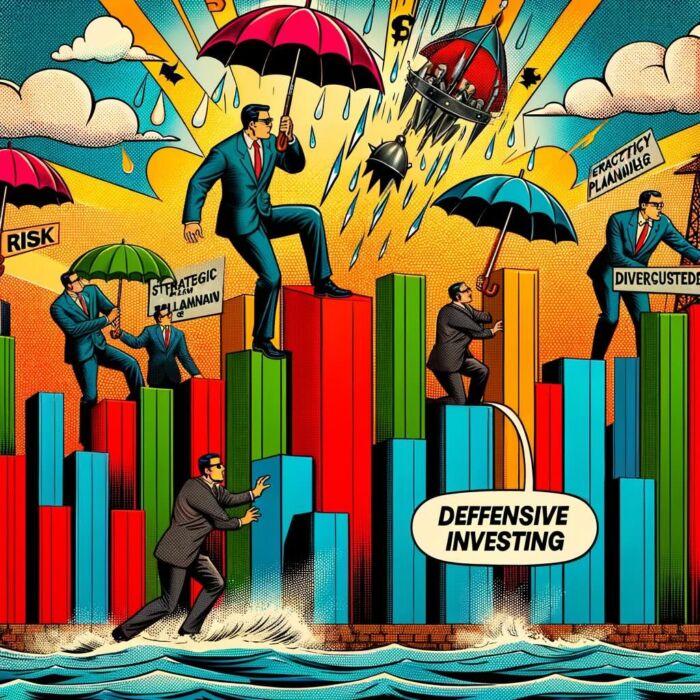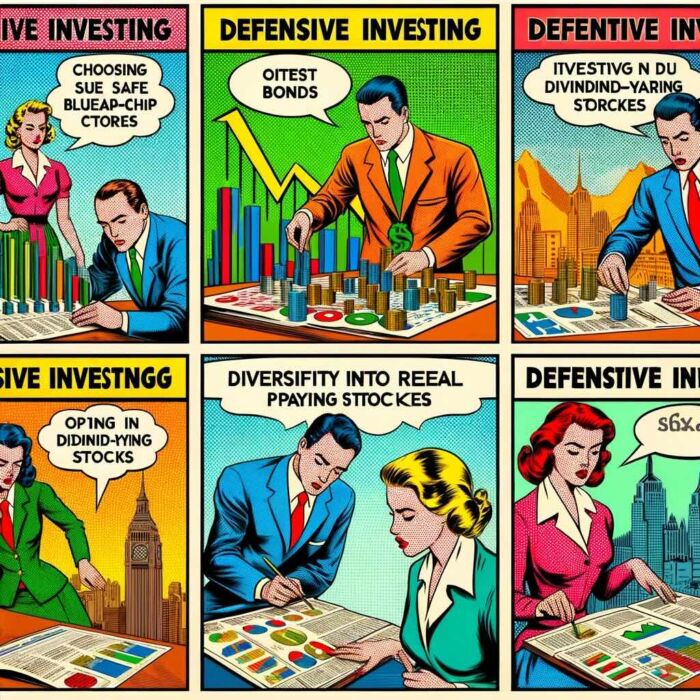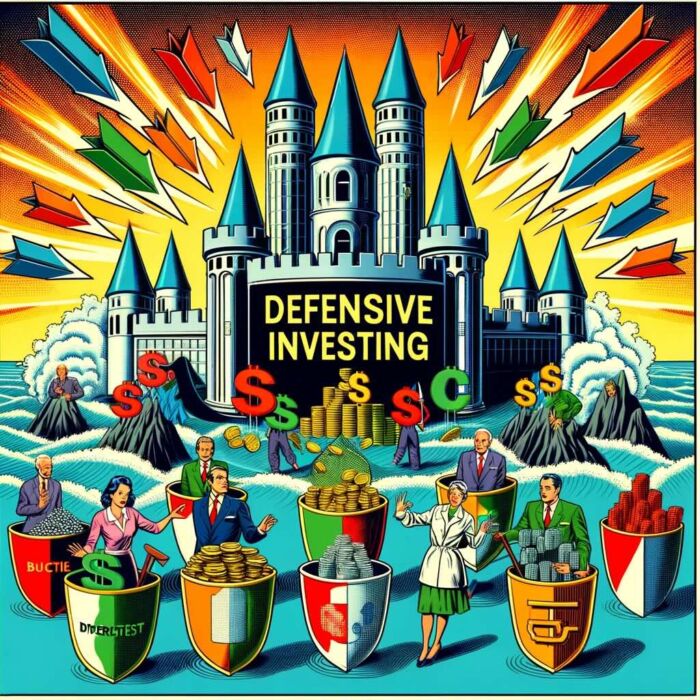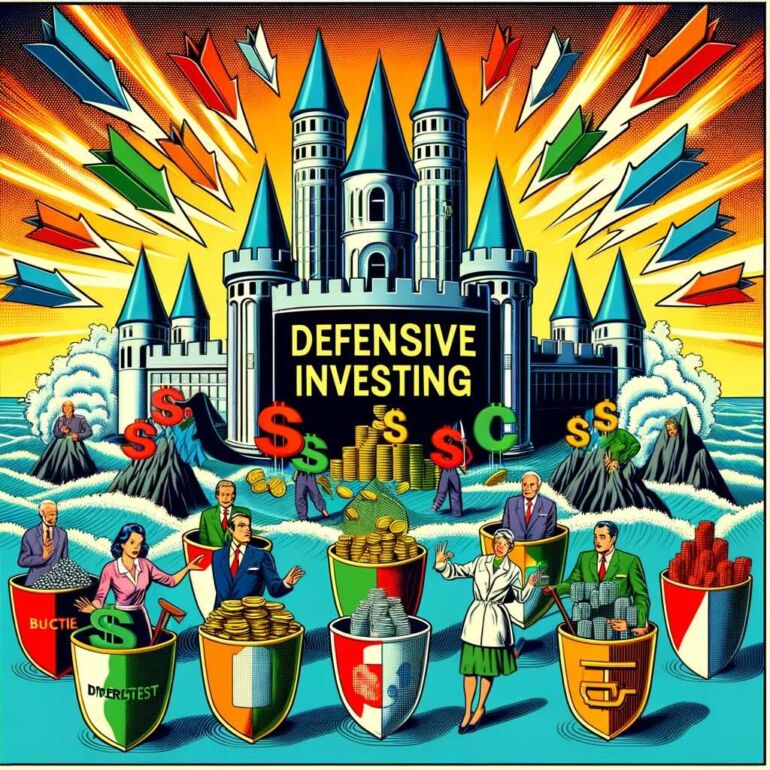The world of investing is often viewed as a battlefield, a place where investors must navigate between the territories of risk and reward. In this landscape, the concept of defensive investing emerges as a crucial strategy. Defensive investing, as the name implies, is primarily about safeguarding the investor’s capital against potential market downturns and volatility. It’s a conservative approach, emphasizing stability and risk management over high-return, high-risk opportunities.
Unlike aggressive investing, which seeks to capitalize on market upswings for maximum profit, defensive investing is akin to a safety net. Its primary goal is not necessarily to earn the highest possible returns, but to prevent significant losses, particularly during periods of economic uncertainty and market turbulence.

Importance of Defensive Investing in Turbulent Times
In the ever-evolving and unpredictable world of investing, dream scenarios of massive returns can often be overshadowed by the harsh realities of market volatility. Economic downturns, geopolitical events, corporate missteps, and sudden shifts in industry trends can all pose significant risks to an investment portfolio. These unpredictable elements can create a tumultuous environment for investments, leading to potential losses.

This inherent unpredictability underscores the importance of defensive investing. While the prospect of skyrocketing profits may seem attractive, the reality is that periods of market boom are often followed by periods of bust. Herein lies the value of a defensive strategy: although it may not lead to phenomenal growth during a bull market, it is designed to mitigate losses during bear markets, thereby offering more stable and predictable returns over time.
In this comprehensive exploration of defensive investing, we delve deeper into its principles and strategies. We examine how this conservative approach can act as a formidable fortress, protecting your portfolio from the relentless storms of market volatility. Providing a roadmap to risk management and capital preservation, we aim to illuminate why defensive investing becomes a lighthouse in the turbulent sea of investing, guiding the way to safer shores. We focus on the actionable insights that can help investors harness the power of defensive investing, to successfully navigate through the choppy waters of financial uncertainty.

Understanding Defensive Investing
Definition and Principles of Defensive Investing

Defensive investing, at its core, is about risk management and capital preservation. It embodies a conservative approach to investment, where the primary goal is not so much the maximization of returns but the minimization of potential losses.
This strategy relies on certain key principles. First and foremost, it values the stability of returns over their magnitude. Defensive investors often gravitate towards securities with lower volatility and more predictability. Second, it emphasizes diversification to distribute and reduce risk. This includes spreading investments across different asset classes, sectors, and geographical regions. Finally, it appreciates the importance of patience, recognizing that investment is a long game where steady, modest returns can accumulate into substantial wealth over time.

The Difference Between Defensive and Offensive Investing
Defensive and offensive investing sit on opposite ends of the risk-reward spectrum. While defensive investing is about capital preservation and risk mitigation, offensive investing is about capital appreciation and risk assumption.
An offensive or aggressive investor seeks out high-growth, high-return investments, often involving higher risk. They are willing to tolerate larger swings in their portfolio value for the potential of significant returns. This approach is often seen in booming markets or sectors, with technology stocks being a classic example.
On the other hand, a defensive investor focuses on stable, lower-risk investments that can generate steady returns over time. They lean towards bonds, blue-chip stocks, and dividend-paying stocks, which typically offer more predictability and lower volatility than their high-growth counterparts.
Benefits and Limitations of a Defensive Investing Strategy
The most significant benefit of a defensive strategy is its potential to shield investors from major losses during market downturns. It provides a level of stability and predictability that can offer peace of mind, particularly for those nearing retirement or with lower risk tolerance. Moreover, it promotes a disciplined approach to investing, encouraging patience and long-term thinking, which are often rewarded in the investment world.
However, defensive investing also has its limitations. It typically offers lower returns compared to an offensive strategy, particularly during bull markets. This approach might not be appealing for those with a higher risk appetite or longer investment horizon, who might be willing to weather short-term volatility for higher long-term gains. Furthermore, while diversification reduces risk, it also means that gains from high-performing assets may be offset by poorly performing ones. Despite these limitations, defensive investing remains a crucial strategy for managing risk, especially during periods of market uncertainty.
source: Rob Berger on YouTube
Role of Defensive Investing in Market Volatility

Market Volatility and Its Effects on Investments
Market volatility is a fundamental aspect of investing. It refers to the degree of variation in the trading prices of securities in the market over a certain period. High volatility is associated with higher risk, as it means prices are changing rapidly in a very short time, which can lead to significant gains or losses.
The effects of market volatility on investments are twofold. On one hand, it can provide opportunities for high returns if an investor can accurately predict price movements. On the other hand, it can also result in significant losses if the market moves in an unfavorable direction. For less experienced investors or those with a lower risk tolerance, market volatility can be a source of stress and uncertainty.

How Defensive Investing Can Protect Against Market Downturns
This is where defensive investing shines. By focusing on low-risk, stable investments, defensive investing can help reduce the potential negative impact of market volatility. For instance, blue-chip stocks and government bonds are known to provide steady returns, even in down markets. This approach also advocates for diversification, which can help to offset losses in one area with gains in another.
Furthermore, defensive investing values patience and long-term thinking. While the market may fluctuate in the short term, a defensive strategy aims for steady, reliable growth over the long term. This means riding out temporary downturns rather than making rash decisions based on short-term market movements.
Historical Examples of Defensive Investing During Market Turbulence
The benefits of defensive investing become particularly evident during periods of market turbulence. Take the 2008 financial crisis, for example. While many aggressive portfolios suffered significant losses, defensive portfolios, with their heavy allocation to safer assets like bonds and blue-chip stocks, experienced less severe downturns.
Similarly, during the dot-com crash of 2000-2002, portfolios with a defensive strategy fared better than those heavily invested in tech stocks. While these examples highlight the value of defensive investing during market downturns, they also serve as a reminder that no strategy is foolproof, and each comes with its own risks and rewards.
source: PensionCraft on YouTube
Defensive Investing Strategies

Diversification and Its Importance in a Defensive Portfolio
Diversification is a cornerstone of defensive investing, essential for managing risk and protecting against volatility. By spreading investments across different asset classes, sectors, and geographic regions, investors can reduce their exposure to any single investment or market segment. Diversification allows for potential losses in one area to be offset by gains in another. It is a risk management technique that helps create a more stable and resilient portfolio.
Defensive investors often combine stocks, bonds, real estate, and other asset classes to achieve diversification. This strategy aims to capture the benefits of various investments while minimizing the impact of market fluctuations on the overall portfolio.
Role of Bonds and Other Fixed-Income Securities
Bonds and other fixed-income securities are integral components of defensive portfolios. These assets offer stability, reliable income, and a known repayment schedule. They serve as a counterbalance to the volatility of stocks and provide a steady stream of interest payments.
Government bonds, municipal bonds, corporate bonds, and Treasury Inflation-Protected Securities (TIPS) are common choices for defensive investors. These investments offer different risk profiles and yield levels, allowing investors to tailor their portfolios based on their risk tolerance and income requirements.
The Place for Blue-Chip Stocks and Dividend-Paying Stocks
Blue-chip stocks are shares of large, well-established companies with a history of stable performance, strong market positions, and proven track records. These companies are known for their resilience and ability to weather economic downturns. Defensive investors often include blue-chip stocks in their portfolios due to their perceived reliability and potential for long-term growth.
Dividend-paying stocks are also favored by defensive investors. These stocks provide regular income in the form of dividends, which can be especially valuable during market downturns. Dividend payments offer a degree of stability and can help cushion the impact of capital depreciation.
Cash Reserves as a Defensive Tool
Defensive investors recognize the importance of maintaining cash reserves as a defensive tool. Cash provides liquidity and flexibility during times of market uncertainty. Holding cash reserves allows investors to take advantage of opportunities that may arise during market downturns, such as purchasing undervalued assets or participating in discounted offerings.
Cash reserves also act as a buffer, enabling investors to avoid forced selling of investments at unfavorable prices. They provide a sense of security and peace of mind, ensuring that essential expenses can be covered without relying solely on the performance of the portfolio.

The Utility of Defensive Sectors in a Portfolio
Defensive sectors, also known as non-cyclical or recession-resistant sectors, are segments of the market that tend to exhibit stability and relative strength during economic downturns. These sectors include consumer staples (e.g., food, beverages, household products), utilities, healthcare, and essential services. Defensive investors allocate a portion of their portfolio to these sectors to help mitigate the impact of broader market declines.
Defensive sectors typically consist of companies that provide goods and services that are necessary for everyday living, regardless of the economic environment. They exhibit more consistent demand patterns and are considered less susceptible to drastic fluctuations in consumer spending. Including defensive sectors in a portfolio can provide additional stability and resilience, particularly during turbulent times.
It is important for defensive investors to continually assess their portfolio’s diversification, asset allocation, and sector exposure to ensure alignment with their risk tolerance and investment goals. Regular monitoring and adjustments are essential to maintaining an effective defensive strategy.
source: Yale School of Management on YouTube
Timing and Implementation of Defensive Strategies
Understanding When to Implement a Defensive Strategy
Timing is crucial when implementing a defensive investment strategy. It involves assessing the market conditions, economic indicators, and overall risk sentiment. While it can be challenging to predict market tops and bottoms accurately, defensive investors typically become more cautious when they observe signs of potential market downturns, such as excessive valuations, deteriorating economic indicators, or heightened geopolitical tensions.
It’s important to note that timing the market perfectly is nearly impossible. Instead, defensive investors focus on a disciplined, long-term approach, making adjustments based on their risk tolerance and overall investment objectives.
Process of Rebalancing a Portfolio for Defensive Purposes
Rebalancing is an essential aspect of defensive investing. It involves periodically reviewing and adjusting the portfolio’s asset allocation to maintain the desired level of risk exposure. Rebalancing ensures that the portfolio remains aligned with the investor’s risk tolerance and investment goals, especially during volatile market conditions.
In a defensive strategy, rebalancing often involves reducing exposure to higher-risk assets, such as growth stocks, and increasing allocations to more defensive assets like bonds or defensive sectors. By periodically rebalancing, investors can avoid becoming overly concentrated in a particular asset class or sector, thereby managing risk and optimizing portfolio performance.

Importance of Patience and Emotional Discipline in Defensive Investing
Patience and emotional discipline are critical elements of successful defensive investing. Market volatility can trigger emotional responses, leading investors to make impulsive decisions driven by fear or greed. However, defensive investing requires a level-headed approach and the ability to stay calm amidst market turbulence.
Defensive investors understand that short-term market fluctuations are inevitable and should not dictate long-term investment decisions. They maintain a focus on their investment goals and the underlying fundamentals of their portfolio holdings. Patience allows them to withstand temporary downturns and adhere to their strategic plan, even when faced with market uncertainties.
Emotional discipline is necessary to resist the temptation of chasing short-term market trends or succumbing to panic-selling during market downturns. Defensive investors recognize that emotions can cloud judgment and lead to irrational decision-making. By maintaining discipline, they can avoid making hasty moves that may undermine the long-term success of their investment strategy.
Overall, defensive investing requires a steadfast commitment to the chosen strategy, an understanding of market cycles, and the ability to exercise patience and emotional discipline. It is through these qualities that investors can navigate through turbulent times and position themselves for long-term success.
source: Yahoo Finance on YouTube
Case Studies of Successful Defensive Investing
Presentation of Case Studies Where Defensive Investing Protected Portfolios

Examining real-world case studies can provide valuable insights into the effectiveness of defensive investing. One notable example is the 2008 financial crisis. During this tumultuous period, defensive investors who had allocated a significant portion of their portfolios to bonds, cash reserves, and defensive sectors experienced smaller losses compared to those heavily invested in high-risk assets. This highlights the ability of defensive strategies to act as a shield during market downturns, preserving capital and mitigating losses.
Another case study is the Dot-com bubble of the late 1990s and early 2000s. Defensive investors who avoided speculative technology stocks and focused on blue-chip companies with solid fundamentals were able to weather the subsequent crash more effectively. By emphasizing stable, dividend-paying stocks and defensive sectors, these investors positioned themselves for resilience in a volatile market environment.
Lessons Learned from These Case Studies
The case studies of successful defensive investing offer several key lessons. Firstly, they underscore the importance of diversification as a risk management tool. Allocating assets across different asset classes, industries, and geographies helps reduce vulnerability to specific market fluctuations.
Secondly, these case studies emphasize the value of a long-term perspective. Defensive investing is not about chasing short-term gains but rather focusing on the sustainability and resilience of investments over time. By remaining patient and committed to their strategies, investors can ride out market volatility and capitalize on long-term growth opportunities.
Additionally, the case studies highlight the significance of understanding one’s risk tolerance. Each investor has a unique tolerance for risk, and a defensive strategy should align with their individual comfort level. While some investors may be willing to take on higher risk for potential higher returns, others prioritize capital preservation and a smoother investment journey.
How These Lessons Apply to Individual Investors
The lessons from these case studies have broad applications for individual investors. Firstly, they emphasize the importance of developing a well-diversified portfolio that aligns with an individual’s risk profile. This entails selecting a mix of asset classes, such as stocks, bonds, and alternative investments, to create a balance that can withstand market volatility.
Secondly, individual investors can benefit from adopting a long-term investment approach. Trying to time the market or chase short-term gains often leads to suboptimal results. Instead, focusing on the fundamentals of investments and maintaining a disciplined strategy can yield more consistent and reliable returns over time.
Lastly, these case studies remind individual investors to remain committed to their investment plan, especially during turbulent times. Emotional discipline plays a significant role in avoiding knee-jerk reactions to market fluctuations. Staying calm, adhering to the chosen strategy, and avoiding impulsive decisions can lead to better outcomes and help investors weather market storms.
By incorporating these lessons into their own investment practices, individual investors can position themselves for success and better navigate the challenges of market volatility.
source: Finance Explained on YouTube
The Role of Defensive Investing in Modern Portfolio Theory

Overview of the Modern Portfolio Theory
Modern Portfolio Theory (MPT) is a widely accepted framework for constructing investment portfolios. Developed by economist Harry Markowitz in the 1950s, MPT aims to maximize portfolio returns for a given level of risk or, conversely, minimize risk for a desired level of return. MPT is based on the notion that investors should focus on the relationship between investments within a portfolio rather than evaluating individual securities in isolation.
MPT introduces the concepts of risk and return trade-off, diversification, and efficient frontier. It suggests that by combining different assets with varying risk levels, investors can create a diversified portfolio that optimizes returns while managing risk.

The Place of Defensive Investing within Modern Portfolio Theory
Defensive investing fits naturally within the framework of Modern Portfolio Theory. The principle of diversification, a key tenet of MPT, aligns with the core philosophy of defensive investing. By diversifying across asset classes, defensive investors aim to reduce the overall portfolio risk and minimize exposure to any single investment. This approach helps achieve a more efficient portfolio allocation that balances risk and return.
Defensive investments, such as bonds, cash equivalents, and defensive sectors, often exhibit lower correlations to equities and can serve as valuable diversifiers in a portfolio. They can help mitigate the downside risk during market downturns and add stability to the overall portfolio performance.

Balancing Defensive and Offensive Strategies for Optimal Portfolio Construction
An important aspect of modern portfolio construction is striking a balance between defensive and offensive strategies. While defensive investing provides stability and risk management, offensive strategies aim for higher returns. Optimal portfolio construction involves finding the right mix that aligns with an investor’s risk tolerance, time horizon, and investment goals.
Defensive strategies can act as a foundation for a well-rounded portfolio, protecting against downside risk and providing stability during turbulent times. However, an entirely defensive approach may limit potential returns, particularly during market upswings. Integrating offensive strategies, such as growth stocks or sector-specific investments, can offer opportunities for higher growth and capital appreciation.
The key is to find the right blend of defensive and offensive assets based on an investor’s risk appetite and investment objectives. This may involve periodic rebalancing to ensure the desired asset allocation is maintained.
Ultimately, the role of defensive investing in Modern Portfolio Theory is to contribute to a more efficient and resilient portfolio. By incorporating defensive strategies alongside offensive ones, investors can optimize risk-adjusted returns and navigate market volatility more effectively.
source: Chris Brycki, Stockspot on YouTube
Defensive Investing: 12-Question FAQ (Practical Playbook for Turbulent Markets)
1) What is defensive investing in one sentence?
A risk-first approach that prioritizes capital preservation, steady income, and smaller drawdowns over chasing maximum returns.
2) Who is defensive investing best suited for?
Investors with low–to–moderate risk tolerance, shorter time horizons (pre/post-retirees), or anyone who wants smoother ride quality and a rules-based plan for selloffs.
3) What are the core pillars of a defensive portfolio?
Diversification across asset classes and regions, sufficient high-quality fixed income (e.g., Treasuries, investment-grade bonds, TIPS), resilience-focused equities (blue chips, dividend growers, defensive sectors), and purposeful cash reserves.
4) How much should I keep in bonds, stocks, and cash?
There’s no one-size mix, but common “defensive tilts” include: 40–60% high-quality bonds (ladder or fund), 30–50% equities tilted to quality/low-volatility/dividend growth, and 5–15% cash/T-Bills for liquidity and rebalancing ammo. Adjust for age, income stability, and spending needs.
5) Which equity types are more defensive?
Quality factor (high ROE, stable margins, low leverage), dividend aristocrats/growers, low-volatility or minimum-volatility funds, and sectors like consumer staples, utilities, healthcare, and some infrastructure.
6) What fixed-income choices fit a defensive plan?
Short-to-intermediate Treasuries for ballast, investment-grade corporates for yield, TIPS for inflation hedging, and municipals (tax-sensitive investors). Avoid overconcentration in long duration if rate risk worries you.
7) What role does cash play?
Cash/T-Bills lower sequence risk, fund spending without forced selling, and provide dry powder to rebalance into drawdowns. A common target is 6–24 months of withdrawals for retirees (or 3–12 months of expenses for accumulators).
8) How do I implement diversification effectively?
Use broad, low-cost index ETFs/mutual funds across U.S./international stocks, varied bond types/durations, and consider real assets (REITs, broad commodities) in modest allocations for inflation shocks.
9) How often should I rebalance—and why?
Check quarterly to annually, or when allocations drift ~20–25% relative (e.g., 40% target equities drifting to 50%). Rebalancing trims winners, adds to laggards, and systematically buys risk when it’s cheap.
10) Are hedges (options/structured notes) necessary?
Not required for most investors. Simpler defenses—allocation, quality tilt, cash, and duration management—usually suffice. If using hedges, size them small, understand costs/roll decay, and treat as supplements, not substitutes.
11) How do I measure if my portfolio is “defensive enough”?
Track maximum drawdown, volatility (stdev), downside deviation, equity beta, and the share of spending covered by reliable income (coupons/dividends/cash ladder). If paper losses threaten plan adherence, you may need more ballast.
12) What’s an actionable defensive checklist I can use today?
Define required return and max tolerable drawdown.
Set target mix (stocks/bonds/cash) and quality tilts.
Build a 6–24-month cash/T-Bill runway (retirees) or 3–12 months EF (accumulators).
Add TIPS and short/intermediate Treasuries; limit credit/duration concentration.
Tilt equities to quality/low-vol/dividend growth; include some defensive sectors.
Automate contributions and set drift-based rebalancing rules.
Pre-commit to a playbook for selloffs (what you’ll buy, when, and how much).
Conclusion: Role and Importance of Defensive Investing in Protecting Portfolios
Defensive investing plays a vital role in protecting portfolios from market volatility and minimizing potential losses. Through diversification, allocation to defensive sectors, and the inclusion of stable assets like bonds, defensive investing helps manage risk and preserve capital. It acts as a shield during turbulent times, offering stability and peace of mind to investors.

Relevance of Defensive Investing in the Current Market Climate
In the current market climate, characterized by uncertainty, rapid changes, and occasional bouts of volatility, defensive investing remains highly relevant. While it may not provide the allure of high-risk, high-reward strategies during bull markets, it serves as a critical risk management tool. Defensive investing allows investors to navigate market downturns with resilience, protect their portfolios, and avoid significant losses.
Moreover, defensive investing offers a sense of stability and control in an unpredictable environment. It provides investors with the confidence to weather market fluctuations and maintain a disciplined approach to investing. This relevance is especially pertinent as investors seek strategies that balance risk and potential returns.

Defensive Investing as a Strategy for Managing Risk and Preserving Capital
Defensive investing is not just a strategy; it is a mindset. It embodies the idea that protecting capital and managing risk are essential components of successful long-term investing. While it may not capture the headlines like aggressive growth strategies, it provides a solid foundation for building and safeguarding wealth.
Defensive investing requires discipline, patience, and a focus on long-term objectives. It is about making rational decisions based on sound analysis, rather than succumbing to short-term market noise or emotional impulses. By embracing defensive investing, investors can navigate through market volatility, preserve capital during downturns, and position themselves for sustainable, consistent returns.
However, it is crucial to note that defensive investing is not a one-size-fits-all approach. Each investor’s circumstances and risk tolerance differ, and their portfolios should reflect their individual needs. It is wise to seek professional advice and conduct thorough research to align defensive strategies with personal financial goals.
In conclusion, defensive investing serves as a shield against market turbulence, providing stability and risk management in uncertain times. By combining diversification, defensive sectors, and prudent asset allocation, investors can navigate the market’s ups and downs with confidence, preserving capital and achieving long-term financial objectives.
Important Information
Comprehensive Investment Disclaimer:
All content provided on this website (including but not limited to portfolio ideas, fund analyses, investment strategies, commentary on market conditions, and discussions regarding leverage) is strictly for educational, informational, and illustrative purposes only. The information does not constitute financial, investment, tax, accounting, or legal advice. Opinions, strategies, and ideas presented herein represent personal perspectives, are based on independent research and publicly available information, and do not necessarily reflect the views or official positions of any third-party organizations, institutions, or affiliates.
Investing in financial markets inherently carries substantial risks, including but not limited to market volatility, economic uncertainties, geopolitical developments, and liquidity risks. You must be fully aware that there is always the potential for partial or total loss of your principal investment. Additionally, the use of leverage or leveraged financial products significantly increases risk exposure by amplifying both potential gains and potential losses, and thus is not appropriate or advisable for all investors. Using leverage may result in losing more than your initial invested capital, incurring margin calls, experiencing substantial interest costs, or suffering severe financial distress.
Past performance indicators, including historical data, backtesting results, and hypothetical scenarios, should never be viewed as guarantees or reliable predictions of future performance. Any examples provided are purely hypothetical and intended only for illustration purposes. Performance benchmarks, such as market indexes mentioned on this site, are theoretical and are not directly investable. While diligent efforts are made to provide accurate and current information, “Picture Perfect Portfolios” does not warrant, represent, or guarantee the accuracy, completeness, or timeliness of any information provided. Errors, inaccuracies, or outdated information may exist.
Users of this website are strongly encouraged to independently verify all information, conduct comprehensive research and due diligence, and engage with qualified financial, investment, tax, or legal professionals before making any investment or financial decisions. The responsibility for making informed investment decisions rests entirely with the individual. “Picture Perfect Portfolios” explicitly disclaims all liability for any direct, indirect, incidental, special, consequential, or other losses or damages incurred, financial or otherwise, arising out of reliance upon, or use of, any content or information presented on this website.
By accessing, reading, and utilizing the content on this website, you expressly acknowledge, understand, accept, and agree to abide by these terms and conditions. Please consult the full and detailed disclaimer available elsewhere on this website for further clarification and additional important disclosures. Read the complete disclaimer here.





